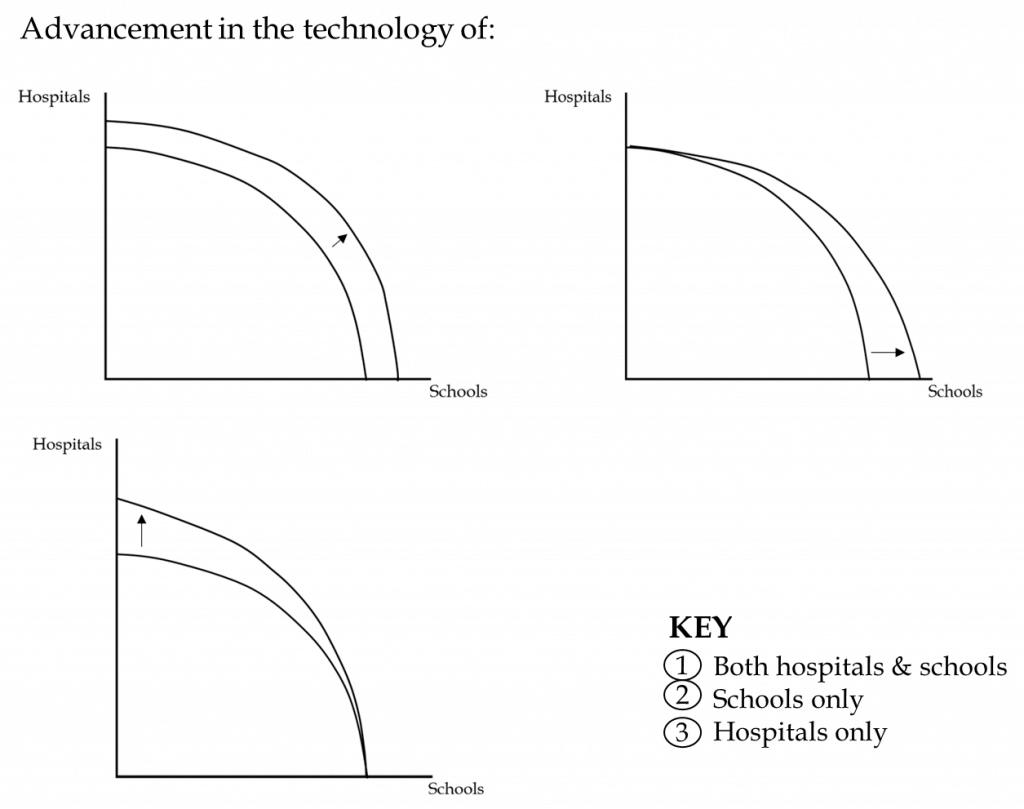<< Lesson 5
Lesson 7 >>
Lesson Overview – this briefly discusses some of the factors that can lead to economic growth in an economy
Although economic growth does not equal development, it is nevertheless a critical ingredient for development. Back to the Human Development Indicator (HDI), education, life expectancy and standards of living are all key components of development over and above national income levels. However, achievement of better health, education and quality of life outcomes requires money, hence the importance of high national income levels. So how does a country achieve growth? This section discusses technological advancements, improvement in human capital and institutions.
5.1 TECHNOLOGY
Technological advancements can allow the production of more output using less input materials than before. To illustrate the concept of technology driven economic growth let us consider an Economics concept called the Production Possibilities Curve (PPC) or Production Possibilities Frontier (PPF).
The Production Possibilities Frontier
Also referred to as the transformation curve, it shows combinations of two goods X and Y that can be produced by a country at full employment or full capacity. It diagrammatically explains the concepts of scarcity, opportunity cost and choice. Figure 7 shows the PPF.

Figure 7 The PPF
Combinations of two goods Hospitals and Schools are represented by the points A, B, C and D, and they are all possible production combinations because they fall on the transformation curve. The area bound by the PPF, the vertical and the horizontal axis are feasible while the area outside this region is not feasible. Point E is not a possible combination because it is beyond capacity. The most likely points in this situation are A and B as compared to C and D which are the extreme points (averages are preferred to extremes). The tradeoff between points A and B (and the negative slope of the PPF) shows opportunity cost because you have to lose some hospitals to produce more schools and vice versa. Point E shows scarcity of resources. Increased production and economic growth can only take place if there is an advancement in technology as shown in Figure 8.

Figure 8 Technology induced growth
5.2 INSTITUTIONS
Institutions (both formal and informal) are a key constituent of the growth and development process. Economic institutions are formal and informal arrangements that govern how a given society functions. Sokoloff and Engerman (2000), maintain that economic institutions were responsible for growth and development in North America and Canada – whereas at the beginning of European conquest these territories seemed worse off relative to Latin America for example.
Institutions have to do with the rule of law, accountability, transparency, governance, corruption, respect for property rights among other issues. Following the arguments by Engerman and Sokoloff (2000), one could embark on an interesting exercise to track the progress of countries that started off at more or less the same economic development level. Almost all the time, differences in development are usually explained in part by institutions. It is well documented in colonial and post-colonial state development economics literature that settler territories performed and still perform better than extractive colonies. In extractive colonies, imperial powers did not invest in sound governance systems as they did not intend to settle in these territories due to tsetse-fly and malaria (among other diseases) induced high mortality. Without a solid state, there is no rule of law and secure property rights. Where there is rule of law and secure property rights, these do not only attract significant external investment but also protect any existing businesses from harm, unfair takeover, riots etc. Therefore businesses will survive, flourish in a stable business environment and contribute positively in society and to development.
The scenario where some countries dismally fail to provide adequate health care systems to citizens even on the back of significant natural resources wealth clearly suggests a lack of accountability as well as the existence of pervasive corruption. At a time of crisis – inadequate planning has a huge human and financial toll (savings are depleted while more loans are sought) which retards economic growth. Investment capital shuns destinations that have poor institutions. The link between institutions and development is clear – there are many other examples. The question is what role can scientists play?!
The major problem when it comes to economic institutions is that they prevent the free market from effectively working. Economic activities that need to be opened up for the private sector to effectively and efficiently produce goods and services are scandalously retained by the government. Corrupt activities thrive on misinformation and murkiness. Without accountability and exposure, no one really knows what is happening and crimes are dismissed as conspiracy theories. Scientists can potentially fundamentally change the status quo through the following interventions (and others) for example.
- Combining Artificial Intelligence (AI), satellite data and other technologies to track illegal activities (e.g., illegal mining, illegal cutting of lumber, trafficking etc..)
- Developing mobile and desktop apps that track usage of national resources
- Developing e-governance apps that help individuals and businesses obtain government services remotely therefore reducing potential of abuse of office by powerful public officials
- Just providing more information so that markets can lean towards perfect competition
Activity 4
- What additional ways do you think scientists can help to create better economic institutions in your country?
5.3 HUMAN CAPITAL
Put simply, human capital is the “stock of skills” possessed by the labor force. Labour or the higher order human capital are part of the production function. The classical production function is specified as:
Output (Q) = Capital (K) + Labour (L) + Technology (T)
By increasing the quality of labour (i.e., human capital development), a firm and eventually the nation can increase its output and national income. Human capital development and STEM education have of late been seen to go hand in hand. STEM is an acronym for science technology, engineering, and mathematics, and it is an important catalyst for economic growth (Rothwell, 2013). Rothwell (2013) posits that on average, STEM jobholders (without necessarily having a four year degree) may earn salaries that are ten percentage points higher than non-STEM occupations at the same level of education. Rothwell (2013) adds that STEM oriented economies perform better in terms of goods and services exports, employment among other indicators.
5.4 NATURAL RESOURCES DISCOVERY
An important assumption of the PPF Theory is that the economy is operating at full employment of all resources. The discovery of natural resources can increase the stock of capital or the stock of inputs in the production process. This should increase output and national income if we consider the production function in the Education and Human Capital Section. However, this is only true in an environment in which the institutional environment is conducive. Otherwise the discovery of natural resources such as petroleum, natural gas and minerals can actually spark conflict, deeped socio-economic challenges and retard economic growth in a poor institutional context. The experience of many countries is that the discovery of natural resources substantially increases exports. Hence in such as a scenario the economic growth may be termed “Export-Led Growth”.
NOTE*: The discussion in this section is just a general overview. This is sufficient for the scope of this course. There are different theoretical models and strategies of economic growth. Models include Harrod-Domar, Solow, Roseinstein Rodan, Roseinstein Rodan, Ragar Nurkse among others. In terms of strategies Export Led Growth model. See here for further reading.
